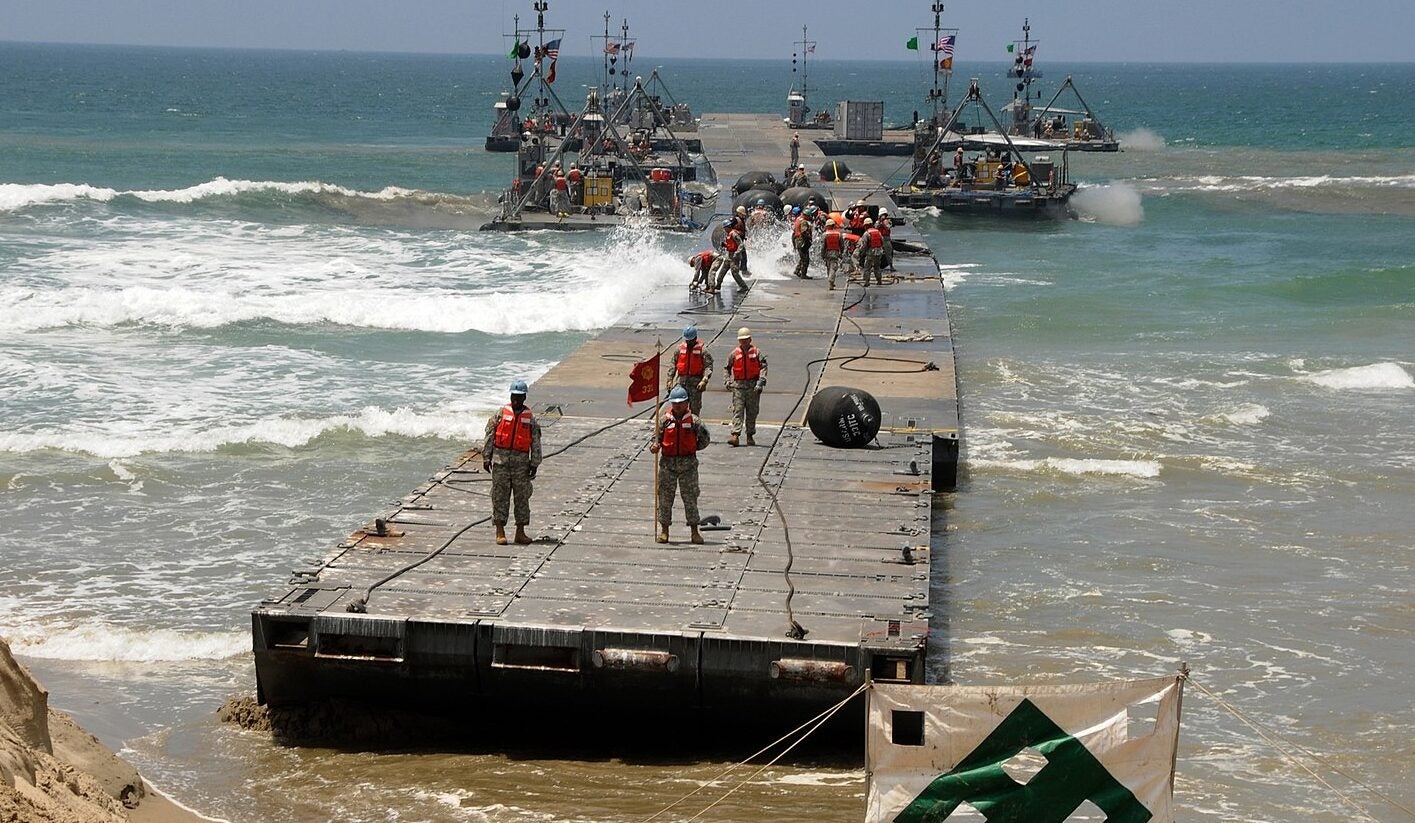
The plan to build a floating pier off a beach in Gaza is borrowing a page from the logistics playbook the Army would likely use in a conflict with China in the Pacific.
The Army announced last week its plans to conduct to build a floating port in the Mediterranean Sea with a pier extending onto a Gaza beach, a tactic the Army calls a Joint Logistics Over-the-Shore, or JLOTS, operation. The operation will involve nearly 1,000 U.S. troops from the Army and Navy, Pentagon officials say, none of which will set foot on Gaza soil.
According to Brig. Gen. John B. Hinson, XVIII Airborne Corps assistant commanding general for support, transporting and resupplying troops and weapons across the region’s large swaths of ocean is a challenge the Army has not faced in many decades.
“If you look at the Indo-Pacific and how island chains are laid out and things like that, you need Army watercraft capability,” Hinson told Task & Purpose, adding that not many understand the service’s water capabilities. For different contingency operations, the Army needs to be able to re-supply itself by ground of air or sea, he said.
This week 70 soldiers from an Army unit that specializes in JLOTS operations, the 7th Transportation Brigade, set sail towards Gaza in an Army-owned ship that carries much of the specialized equipment. Once offshore, the soldiers onboard will deploy an 1800-foot modular pier, known as a Trident Pier, that links ships carrying equipment to shore.
An Old Tactic In New Fights
JLOTS isn’t new for the Army. Soldiers deployed a JLOTS pier to deliver humanitarian supplies in Haiti in 2010 and a full JLOTS exercise was part of Talisman Sabre exercise in Australia six months ago. JLOTS operations are a staple of planning and training exercises in the region, where logistics is a major sticking point for potential conflict with China.
During Talisman Sabre 2023, Navy sailors provided construction and heavy equipment support and Coast Guard units provided port security aboard patrol craft.
The crews now headed to Gaza, Hinson said, will be well prepared by the Australia exercise, in which the sea state of wind, waves and swells were higher than crews will likely find in the Mediterranean.
“If you have a sea state that’s a little higher, then that will affect your throughput – your throughput could go down and then there is a certain time if there’s storms or whatever, where you may actually have to stop operations until the sea state goes back down,” he said.
But once up and running, a JLOTS beachhead should make an immediate impact on the food, water and medical supplies in Gaza.
“It just increases exponentially the amount of throughput that we can have every single day. Once we become fully operational, we can push up to 2 million meals a day,” Col. John B. Hinson, Assistant Commanding General of Support for XVIII Airborne Corps told Task & Purpose. “That’s a capability that we just don’t have right now for aerial delivery.”
Humanitarian Relief
Israel has largely shut off entry of food, water, medicine and other supplies after it launched its assault on Gaza following the Oct. 7 attack on southern Israel by Hamas militants who killed nearly 1,200 people and took 250 people hostage.
For the last few months, Israel has allowed a handful of aid trucks through two areas in the south. But officials have warned that the amount of humanitarian aid is just not enough for the millions of Palestinians at risk of dying from lack of food and potable drinking water.
The UN reported last week that at least 20 children, including a 14-month-old baby have died from starvation. UN Special Rapporteur for food Michael Fakhri said that nearly 75% of the Gaza strip’s fishing sector had been devastated by Israeli bombings along with Israel denying residents all access to the sea.
It’ll take around 30 days for Army crews to travel to the region and another 10 to 14 days for setting up the roll on and roll off capabilities, according to Hinson. Officials are still figuring out how to bring the aid off the ships and on to land for distribution, he said.
“We will never have boots on the ground, but we’re still going through the different courses of action on the actual path that will happen on the pier,” Hinson said.
